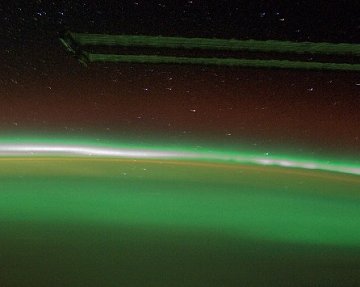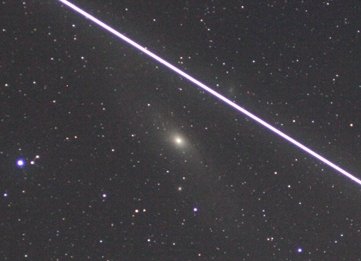| Where's Saturn? Is that a UFO--or the ISS? What's the name of that star? Get the answers from mySKY--a fun new astronomy helper from Meade. | |  | AURORA WATCH: Sky watchers around the arctic circle should be alert for auroras on Feb. 10th. That's when a solar wind stream is expected to hit Earth, sparking high-latitude geomagnetic storms: gallery. THE VIEW FROM ABOVE: When the solar wind arrives and auroras flare up, a great place to be is Earth orbit. Here is the view from the International Space Station (ISS), 200 miles high: 
Crewmembers took the picture during a mild geomagnetic storm on Feb. 1st. At the time, the ISS was orbiting over the Bay of St. Lawrence and the camera (a Nikon D2Xs) pointing north with a view of Quebec and New Foundland. More images: #1, #2, #3, #4, #5. Although the auroras appear to be below the ISS, they are in fact at about the same altitude. Indeed, from time to time, the space station flies right through the Northern Lights--an indescribable experience according to astronauts who have been there. Will they experience the indescribable this weekend? A solar wind stream is en route and could put on a lovely show for the combined crews of the ISS and space shuttle Atlantis. Stay tuned! SIGHTINGS: Last night the International Space Station flew over Borken, Germany--and right by the Andromeda Galaxy. Günther Strauch snapped this picture using his Canon EOS 20D: 
Halfway across the Continent in Normandy, France, Stephane Palfray trained her 4.5-inch telescope on the bright streak and easily resolved the station's solar arrays and living quarters: image. The station has grown so large, "it only takes a small telescope to see the details," she says. Today, space shuttle Atlantis docked with the ISS, adding even more to the station's size and lustre. Sky watchers in Europe and North America, ready your telescopes for a series of bright flybys in the nights ahead: flyby alerts. more images: from John Locker of Wirral UK; from Quentin Déhais of Near Le Havre, Normandy, France; from Robert Malmström of Reutlingen-Rommelsbach, Germany; from Francesco De Comite of Mouscron Belgium; from Mark Thomas of Nottingham, England, UK; from Roy Keeris of Zeist, The Netherlands; | 
